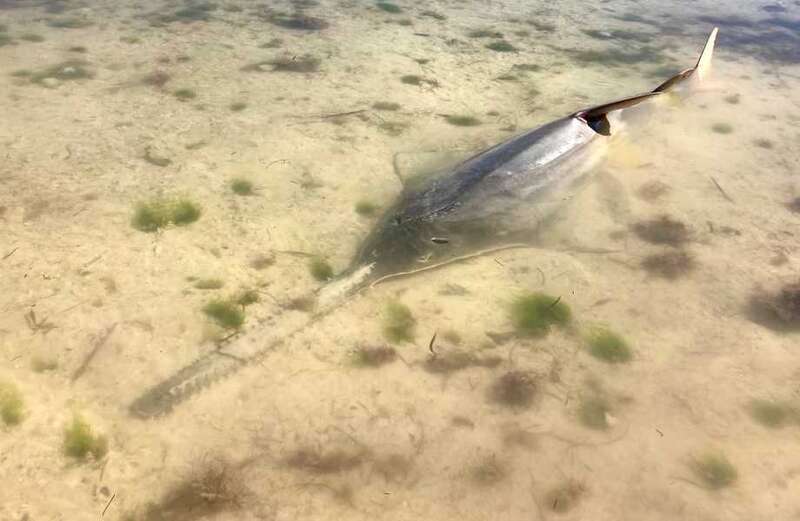MARINE experts are still confused about the abnormal and mysterious mass beaching of endangered sawfish.
They've spent months trying to work out why distressed fish are swimming in circles before stranding themselves in the Florida Keys.



However, microscopic lesions have been found in the organs, including brain tissue, of the dead sawfish, said scientists who are carrying out necropsies - an animal “autopsy."
Other species of fish also appear to have been affected.
Endangered smalltooth sawfish have for months been spotted erratically spinning and whirling in the sea, and dying in unusually high numbers in Florida waters.
 Andrew Tate 'tried to lure ex-Playboy model to Romanian lair' before his arrest
Andrew Tate 'tried to lure ex-Playboy model to Romanian lair' before his arrest
The Florida Fish and Wildlife Conservation Commission (FWC) was first alerted to bizarre reports of spinning fish last fall.
And smalltooth sawfish - which have a long, flat snout edged with teeth that looks like a saw - have been dying in droves since late January 2024.
DOZENS DIE
The abnormal fish die-off has killed at least 45 sawfish and other fish species as well over the past four months.
“We suspect that total mortalities are greater, since sawfish are negatively buoyant and thus unlikely to float after death,” said Adam Brame, National Oceanic and Atmospheric Administration (NOAA) Fisheries’ sawfish recovery coordinator.
"The cause, or causes, of the abnormal behavior and mortality of fish in the Florida Keys (prominently including sawfish) remain unknown," Theresa Cody, associate research scientist at the FWC) Fish and Wildlife Research Institute, told Live Science.
Experts are continuing their desperate race to establish the cause of the mass die-off, and to save this ancient and endangered fish.
Sadly, even with our best efforts, the animal was ultimately too compromised to recover.
Dr Michael P. Crosby
So far, researchers have examined dissolved oxygen, salinity, pH, and the temperature of the Florida Keys.
Scientists have also conducted water testing for more than 250 chemicals where they've been seen spinning and whirling.
"All parameters were either not detected or were below any biological thresholds, with most being below minimum detection limits," said the FWC.
 Inside US's most remote town 2.4 miles from Russia where only 77 people live
Inside US's most remote town 2.4 miles from Russia where only 77 people live
"Sediment sampling results for heavy metals are pending.
"Tested specimens do not [show signs of] bacterial infection.
"FWC has sent more than 300 fish tissue samples to the University of South Alabama for toxin analyses."
BRAIN LESIONS
Scientists are also examining tissue taken from dead sawfish in an effort to detect parasites, bacteria, and fungi, as well as pathological changes and abnormalities, it added on Facebook.
"Our investigation is ongoing, and our team is planning to... further assess microscopic lesions that have been found in the organs, including brain tissue," the FWC said in an update last Friday.
REPORT SPINNING
The organization has issued a plea on social media for anyone seeing a distressed sawfish to contact it immediately.
"Report all healthy, sick, injured, or dead sawfish to FWC’s sawfish hotline at 844-472-9347," it said.
"Under the Endangered Species Act, it is illegal to catch, harm, harass, or kill an endangered sawfish.
"If you see abnormal fish behavior, fish disease, and fish kills, submit a report to FWC’s fish kill hotline either through the web form MyFWC.com/ReportFishKill or by calling 800-636-0511."
Sadly, efforts to save distressed sawfish have proved difficult.
In April, an 11-foot (3.3-meter) smalltooth sawfish was seen swimming in circles near Cudjoe Key and reported by a member of the public.
The distressed sawfish was rescued and taken for rehabilitation at Mote Marine Laboratory in Sarasota.
But on May 3, the lab said it was distraught to report its attempt had failed.
RESCUED
"The Mote Marine Laboratory family is heartbroken to report the sad news that the distressed smalltooth sawfish that was rescued on April 5 passed away on May 2," it said.
"The team worked tirelessly to improve the animal’s condition in hopes it could eventually be released back into its natural environment.
"Under guidance by NOAA and FWC, the decision was made to humanely euthanize the sawfish when the animal’s condition deteriorated."
"Although heartbreaking, this outcome was not surprising," said Dr Michael P. Crosby, CEO of the lab.
"We worked restlessly for 24 hours a day to provide the most advanced treatment available.
"Sadly, even with our best efforts, the animal was ultimately too compromised to recover.”
PROTECTED
Although sawfish have shark-like bodies, they are actually a type of ray.
Smalltooth sawfish were once found in the Gulf of Mexico from Texas to Florida and along the East Coast from Florida to North Carolina.
Now though, their numbers in U.S waters are greatly diminished, and the species is generally only found off the coast of Florida.
The mainly eat fish but may also consume invertebrates such as shrimp and crabs.
The smalltooth sawfish was the first marine fish to receive federal protection as an endangered species under the Endangered Species Act in 2003.





































